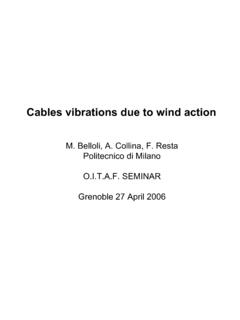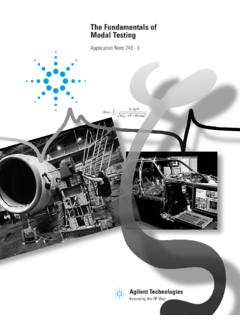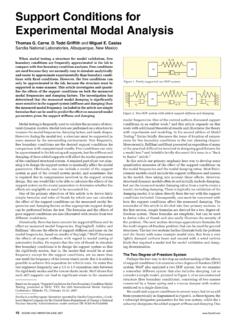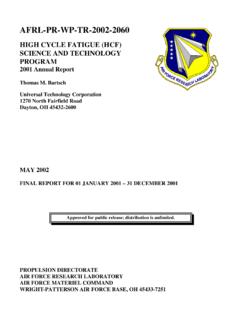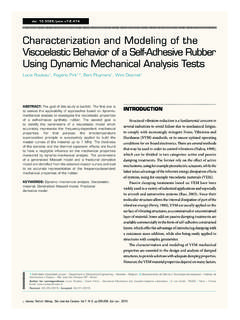Transcription of GROUND VIBRATION PREDICTION AND …
1 GROUND VIBRATION PREDICTION AND ASSESSMENT Thornely-Taylor Rupert Taylor Ltd 1. INTRODUCTION VIBRATION is often grouped with noise and regarded as a kindred topic. Noise, after all, begins as VIBRATION , and VIBRATION is as much a part of acoustics as is noise. By comparison, though, noise is simple. It always occurs in air, and except in special circumstances ( in reactive near fields) the characteristic impedance of air is more or less always the same. So much so that we have standard methods of measuring sound power based on the measurement of sound pressure.
2 The biggest complexities arise with velocity gradients in long distance propagation. Airborne sound almost always propagates as a compression wave, and the speed of sound is about the same at all frequencies. Damping due to air viscosity and boundary absorption is reasonably well understood. Only at very high intensities does airborne sound propagation become non-linear. VIBRATION , by contrast, occurs in media ranging from rock or solid concrete, through water and soil to lightweight panels.
3 It can propagate as a compression wave, a shear wave, a variety of surface waves, bending waves, torsional waves, either separately or together. It can propagate in two different media at the same time ( water contained in porous rock and the rock itself). The propagation velocity of bending waves is frequency dependent. Damping can occur either through viscosity, or because of hysteresis or because of relaxation effects in solids and the mechanisms are not all properly understood.
4 Sources of VIBRATION such as machinery out of balance, moving loads and discontinuities are capable of moderately straightforward GROUND VIBRATION PREDICTION And Assessment Thornely-Taylor mathematical description and manipulation. Transmission of VIBRATION , and reception at the point of interest is beset with complexities and uncertainties. To minimise the uncertainties, much more detailed PREDICTION and modelling methods are required than is the case with airborne noise, and complex assessment methods are required.
5 2. CONSIDERATIONS IN PREDICTION Receiver Usually the most sensitive receptor is the human body. Whereas we have but two ears, we can sense VIBRATION in any part of the body, and our response is dependent on direction. What may be x-axis VIBRATION becomes y-axis or z-axis VIBRATION by the simple act of a human receptor lying down. Going to bed does more than change the axis, because the impedance of the bed is very different from the impedance of the floor.
6 Even the impedance of the floor varies according to location. Standing on the floor changes its impedance. Apart from the problem of axis changes, the human body though dynamically complex is a load impedance. The magnitude of a VIBRATION signal transmitted into the body depends not only on the amplitude (displacement, velocity or acceleration) but also on the impedance of the system as seen from the point of contact with the body. The significance of the effect of the body on VIBRATION reception from a surface varies according to the impedance of the system.
7 A concrete slab is more or less a constant-current source and the input to the body can be determined by the VIBRATION amplitude of the slab without the presence of the body. The VIBRATION of the surface of a mattress gives little direct indication of the VIBRATION of a body that might lie on it. BS 6472:1992 advises that measurements of VIBRATION should normally be taken on a building structural surface supporting a human body. In some circumstances, measurements may be made outside the structure, or on some surface other than at the point of entry of VIBRATION to the body.
8 Where measurements are made other than at the point of entry of VIBRATION to the body an allowance should be made for the transfer function between the measurement point and the point of entry to the body. Figure 1 shows the impedance of the human body [1]. This can be idealised as a system of lumped parameters [2] with five degrees of freedom. GROUND VIBRATION PREDICTION And Assessment Thornely-Taylor + + + + + + + +040510152025 Frequency, HzMagnitude (Ns/m)Female, 56kgMale, 75kgFigure 1 Driving-point impedance (z-axis) of seated human body Path Uncertainties associated with the relationship between floor VIBRATION and VIBRATION perceived by a human recipient are compounded by the variable response of different parts of the building structure.
9 VIBRATION in the GROUND will not be coupled simply to the building foundations, and the local response of the building will depend on the impedance of building elements. A monolithic "building" with a raft foundation on soil is in fact a mass-spring system itself. The spring constant of the soil, the damping ratio and added mass are given by the following expressions [3]: Spring Constant Viscous damper Added Mass Vertical K 4Gr/(1- ) (Kpr3) r3 Horizontal (1- 2)/(2- )2 ( Kpr3) r3 Where r = radius of plate; G = modulus of rigidity; = Poisson s ratio; = mass density There are also rocking and torsional degrees of freedom.
10 The mass-spring behaviour of such a building influences the soil-structure interaction and the coupling loss factor between the soil and the building. GROUND VIBRATION PREDICTION And Assessment Thornely-Taylor Floors in the building have natural frequencies, which if the floor is assumed to be either a plate with hinged edges or clamped edges, solutions for which are available [4]. At any one of those natural frequencies the floor impedance would be very low and controlled largely by damping, such the VIBRATION amplitude would rise to very high levels for a continuous input signal.
